Super World Stadium '92/Walkthrough
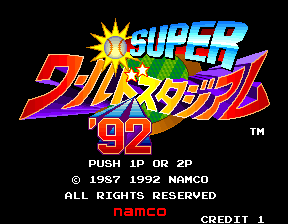
Once you have inserted a coin into the cabinet of Namco's Japan-only 1992 baseball arcade game Super World Stadium '92 the text "PUSH 1P OR 2P" will appear upon the screen (like all four of its predecessors, it allowed two players to play on one credit); you will then have to press either that 1 Player Start Button or the 2 Player Start Button to proceed to the new team selection screen as the introductory theme starts to be heard from the Yamaha YM-2151. You will then be given forty-four seconds (which is two more than in the immediate predecessor) to select one of the game's twelve new teams by pushing the joystick up, down, left, and right, before pressing that first button to confirm your choice - and as in all four of the previous games, if you had only pressed that 1 Player Start Button, you will now have to select another team for the CPU to predetermine the behaviour of, but if you pressed the 2 Player Start Button, that second player will now have to pick another team to take control of (which, as in all four of the previous games, is too bad if the first player happened to have chosen the team he wanted to take control of). All twelve teams are also real, and their namings reflect their 1991 lineups.
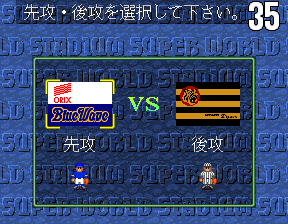
The game will then proceed to the new position selection screen, as the timer in the top-right corner of the screen continues counting down; it displays the flags of both players' chosen teams, with the Kanji text of senkō (先攻) which means batting first (1P), and kōkō (後攻) which means after the attack (2P), beneath them, along with a player from that first player's chosen team (in his home outfit) and another one from that second player's chosen team (in his away outfit), so either player can push their joystick to the right for changing the player from the first player's team into his away outfit and the other player from the second player's team into his home outfit (the Kanji texts will also swap positions) and push it back to the left after doing so to change them back to how they were before, then press the first button to confirm their choice. The game will now proceed onto its new defensive-half selection screen, which displays the flags of the Central and Pacific Leagues with the Kanji/Hiragana texts DH-sei nashi (DH制無し), which means no defensive-half system (Central League flag), and DH-sei ari (DH制有り), which means defensive-half system (Pacific League flag), beneath them, and once you have pushed that first button to confirm your choice (after either player has pushed their joystick to the right to select the latter option if they wish), the game will proceed onto its new team lineups screen - and each of the 96 players' names will also have their abbreviated positions next to them, but the name next to the number 9 will now always be tōshu (投手), which means pitcher, with a "P" next to it, given that the game has not proceeded to the new pitcher selection screen yet. But when it does, the timer will still continue counting down, and you will now have to select one of your chosen team's six pitchers (the static images of whom will be displayed upon the screen, as you push your joystick up and down to highlight them), and if you only pressed the 1 Player Start Button, the CPU will automatically select the first of its team's six pitchers to predetermine the behaviour of (it does not give the illusion of random selection any more); all 72 pitchers' names also have either the letter "L" or "R" next to them, indicating whether they will pitch while facing the left or the right. The game will then proceed to the stadium selection screen - and you will now have to select one of the game's four stadiums for the match to take place in (the second of them is also the Hanshin Tigers' home stadium), which all have different "left", "centre", and "right" measurements (given in metres for the first three stadiums, but feet for the last one):
| Stadium | Name | Sayoku (左翼) | Chūken (中堅) | Uyoku (右翼) |
|---|---|---|---|---|
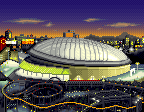
|
Dome (ドーム) | 100.0m | 122.0m | 100.0m |
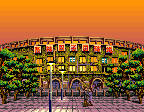
|
Kōshien (こーしえん) | 96.0m | 118.1m | 96.0m |
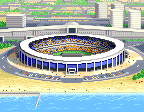
|
Seaside (シーサイド) | 99.5m | 122.0m | 99.5m |

|
Manhattan (マンハッタン) | 338ft | 410ft | 338ft |
Once you have pressed the first button to confirm your choice, the theme that you have been hearing from the Yamaha YM-2151 since you had pressed either the 1 or 2 Player Start Button will fade out as the image of your chosen stadium moves into the centre of the screen and the camera zooms in on it as the unseen 46000-, 55000-, 30000-, or 55601-strong crowd cheer from the C140, before zooming out on a view of your two chosen teams' statistics...
-
The Seibu Lions' and Kintetsu Buffaloes' statistics.
-
The Hiroshima Tōyō Carp's and Chūnichi Dragons' statistics.
-
The Orix Blue Wave's and Nippon-Ham Fighters' statistics.
-
The Yakult Swallows' and Yomiuri Giants' statistics.
-
The Fukuoka Daiei Hawks' and Chiba Lotte Marines' statistics.
-
The Yokohama Taiyo Whales' and Hanshin Tigers' statistics.
...for the 1991 season, as the match opening theme is heard from the Yamaha YM-2151; they display the flags of both teams with the Kanji text kantoku (監督), which means "director", and the names of their managers below them. The Kanji text of 1991 nendo-seiseki (1991年度成績), which means "1991 results", will also be displayed below that, with three numbers next to the Kanji characters shō (勝), which means "wins", hai (敗), which means "losses", and bun (分), which means "draws" (however, the Yomiuri Giants and Hanshin Tigers did not have any draws in that season), below it - and that unseen crowd will then cheer from the C140 again as all eighteen players run out and take their positions upon the field of your chosen stadium for the fifth time.
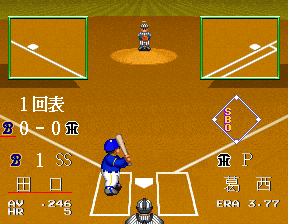
The view will now change to a shot of the centre of the stadium's field, as the Katakana text purei bōru (プレイボール), which means "play ball", appears on the screen, and the game's first main theme starts to be heard from the Yamaha YM-2151 (if you had selected either the Dome or Kōshien Stadiums, the two main themes will be remixes of those from World Stadium '89 & '90 - but if you had selected either the Seaside or Manhattan Stadiums, the two main themes will be brand-new compositions). The score will be displayed upon the left side of the screen (with the batting team's initial again underlined in red) under the number 1, and the two Kanji characters of kai omote (回表), which again means "front time"; the statistics of the No. 1 from that first player's team will also be displayed in the bottom-left corner of the screen below that team's initial. The statistics of the chosen pitcher from the second player's team will also be displayed in the bottom-right corner of the screen, below the team's initial - that first player must use his joystick to position his batter inside the batting box, and the second player must push his joystick to the left or right to position his pitcher upon the pitcher's mound, then press his first button to throw the ball. He must now push the joystick left if he wants the ball to curve horizontally, down-left to curve vertically, right to shoot horizontally, down-right to shoot vertically, down to fork, and up to be a speed ball - and if the other player's team's current batter failed to hit it, the Katakana text sutoraiku (ストライク), which means "strike", will appear upon the screen with the speed at which the ball travelled in kilometres above it, as a yellow circle appears next to the letter "S" on the right side of the screen. You both then have to repeat the pitching process, but if the other player's team's current batter fails to strike the ball again, that Katakana text sutoraiku (ストライク) will again appear on the screen with the speed at which the ball travelled in kilometres above it, as a second yellow circle appears; you'll both then have to repeat that pitching process again, but if the other player's team's current batter fails to hit that ball once again, the Katakana text battā auto (バッターアウト), which means "batter out", will appear on the screen (with the speed at which the ball had travelled in kilometres above it), as both yellow circles next to the letter "S" disappear and an orange circle appears next to the letter "O" below it and the other player's team's next batter is brought in - who will have different statistics. New secondary themes will also be heard of from the Yamaha YM-2151 when specific players are at bat for each team.
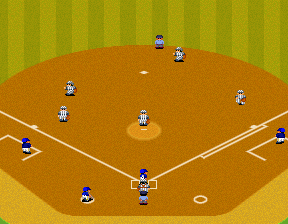
The first player must press the first button to make his batter swing and the second button to make him bunt; once he has struck the ball, the view will change to a shot of your stadium's field as it flies up into the air. If the ball does not land within the white lines, the umpires (of which there are six) will hold their arms up and the Katakana text fauru (ファウル), which means "foul", will appear upon the screen, and it will be counted as a strike - this will also be signified by a yellow circle appearing next to that letter "S", once the view returns to the image you see above. Also, if the current batter hits the ball so hard that it flies out of the stadium, the Katakana text hōmu ran (ホームラン), which means "home run", will appear upon the screen with the distance that the ball travelled in metres next to the Kanji text hikyori (飛距離), which means "flying distance", and the Katakana (or Kanji) text for where the ball landed (レフトスタンド: "left stand", バックスクリーン: "back screen", ライトスタンド: "right stand", ラッキーゾーン: "lucky zones" for the Kōshien Stadium, and 場外: "curb" in all excepting the Dome Stadium) as a dramatic jingle is heard from the Yamaha YM-2151 (if you had selected either the Dome or Kōshien Stadiums, it will be a remix of that of the three NS1-era titles, but if you had selected either the Seaside or Manhattan Stadiums, it will again be a brand-new composition). The current score will then be displayed upon the screen (the teams are now represented by their logos) as a special effect happens in the background; the floodlights will flash on and off for the Dome Stadium, one to nine Namco blimps will fly into view from the left side of the screen for the Kōshien Stadium, a whale will emerge from the ocean and spout water from his blowhole, a galleon will sail into view from the left side of the screen and fire its cannons, three blue jet planes will fly into view from the left side of the screen and skywrite "BRAVO, BRAVO, BRAVO." for the Seaside Stadium as hundreds of balloons are released into the sky, and a spaceship will fly into view from the left side of the screen for the Manhattan Stadium. If the ball landed within the white lines after your chosen team's current batter hit it and one of the other players on your chosen team caught it as it fell back down to the ground, you will have to press the first button to make him throw it to one of the other players while pushing your joystick up and down to indicate which player you want him to throw it to; once you have done so, all the umpires will hold their arms out and the Katakana text sēfu (セーフ), which means "safe", will appear on the screen if the player was safe, or the umpires will hold their right arms up and the different Katakana text auto (アウト), which means "out" will appear upon the screen if he was out (yet again, this will also be counted as an out, and it will be reflected an orange circle appearing next to the letter "O" once the view has returned to that screenshot you see above). The radar of the field which appears at the bottom of the screen shows the positions of the other team's players (they're indicated by the moving hats, which now match the colour of their own) - and when your team's batting and the other player's team is pitching, push the joystick up and press the first button to tag out a runner on the other player's team who's attempting to steal a base (they can be seen in the windows on the left and right sides of the screen now). Once you've done so, the runner will run out of sight from the left side of the screen, as the other player's team's chosen pitcher throws the ball; once your team's current batter has struck the ball the view will again change to a shot of the field as it flies up into the air, but the other player's team's chosen pitcher will then run off the pitcher's mound, and onto the catcher's plate. You will now have to push your joystick to the left and press the first button to make your chosen team's runner start running, then push your joystick up, and press that second button to make him run back again - and once three outs have occurred, the view will cut to a shot of the sky above your chosen stadium (however, if you chose the Dome Stadium, that shot will be of its ceiling; the sky above the Kōshien Stadium will again darken after three full innings have been played, and again after six full innings have been played), with a scoreboard at the top of the screen, a list of the next 3 batters on that left side of the screen, and a mascot on that right side of the screen (seven of the teams have a pair of palette-swapped female cheerleaders as mascots - six of them hold vuvuzelas, and the Chiba Lotte Marines' pair hold umbrellas, but the other five teams all have a unique mascot, as you can see in those images below). The camera will then pan to the right as one of two organ-like jingles (the one you hear depends on whether your team scores any runs or not) from the previous game is heard from the Yamaha YM-2151.
-
Seibu Lions' "Leo".
-
Orix Blue Wave's "Neppy".
-
Yomiuri Giants' "Giabbit".
-
Fukuoka Daiei Hawks' "Harry".
-
Hanshin Tigers' "Lucky".

It will now be the first player's turn to pitch and the second player's (or the CPU's) turn to bat; the score display will also have the initial of the second player's team underlined in red as a result of this, and the text above will now read as the Kanji/Katakana of kai ura (回ウラ), which means "back time". The game continues until preset number of innings (depending on what that arcade owner has set "CONTINUE1" and "CONTINUE2" settings in the game's options menu to), have been played (you then have to insert another coin, and press either Start Button within 15 seconds, to continue your game each time). Once nine full innings have been played, or the losing team are down by ten runs in the bottom of any inning (however, if both of your teams have the same amount of runs after nine full innings have been played, your game will continue, for up to three extra ones), the Katakana text gēmu setto (ゲームセット), which means "gameset", will appear upon the screen, as the match's ending jingle is heard from that Yamaha YM-2151 - and the image of your chosen stadium from the stadium selection screen will now zoom into view in the centre of the screen as the text "NAMCO SPORTS NEWS" flies into view from the left side of the screen below it. One of two dramatic jingles will then start to be heard from the Yamaha YM-2151 (the one you will hear depends on whether your match was called or not) as the view cuts to a shot of a screen in a studio showing the winning team's name in Katakana, with either the two Kanji characters asshō (圧勝), which means "complete victory", or the two different Kanji characters of kaishō (快勝), which means "easy victory" next to it; the number of runs that both teams scored during the top and bottom of each inning will also be displayed below that, along with the name of your chosen stadium in Katakana (or Hiragana for players who still favour the Kōshien Stadium) and its maximum capacity. The text "GAME OVER" will then appear upon the screen, and the game will go back into attract mode.
-
Dome Stadium asshō report.
-
Dome Stadium kaishō report.
-
Kōshien Stadium asshō report.
-
Kōshien Stadium kaishō report.
-
Seaside Stadium asshō report.
-
Seaside Stadium kaishō report.
-
Manhattan Stadium asshō report.
-
Manhattan Stadium kaishō report.
Also, because a game can now only last up to twelve full innings, it is again possible for both teams to score the same amount of runs after this amount of innings has been played; in such cases, a kaishō report will be invoked at the end of the game, but the screen will show the name of the first player's team in Katakana with the Kanji/Hiragana text hikiwake (引き分け), which means "draw", next to it. The text of "GAME OVER" will then appear as usual.

















